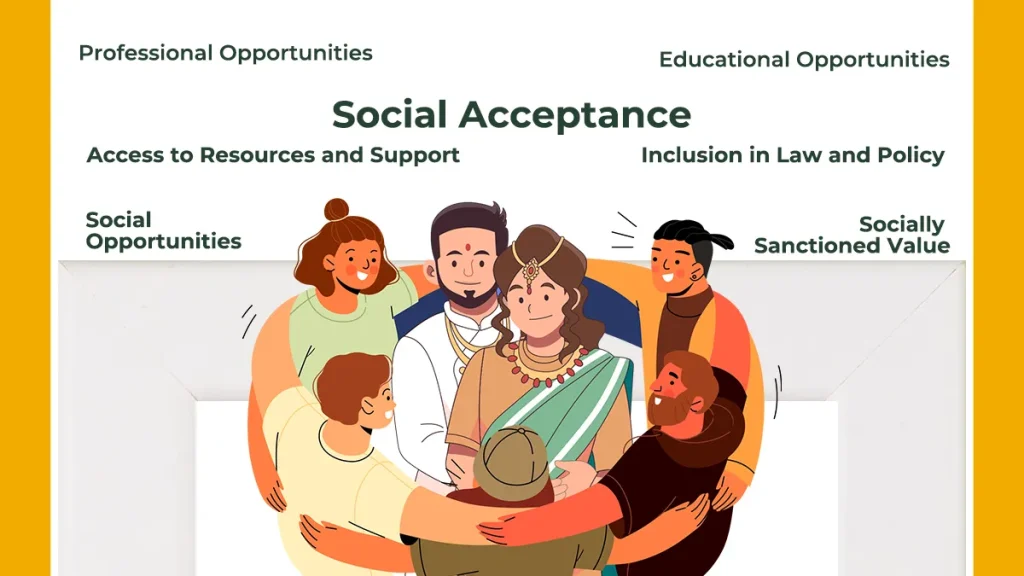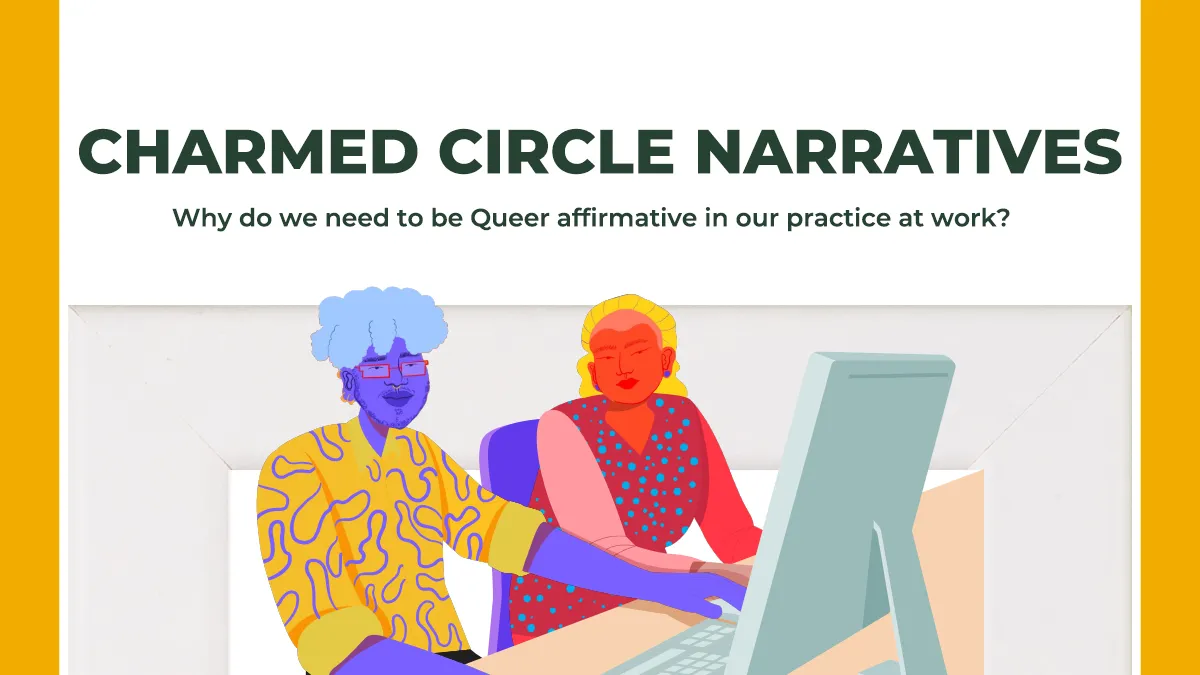To engage in affirmative action means to understand, acknowledge and work to address the gaps brought on by historic or systemic oppression and discrimination in an individual’s life. By bringing a queer affirmative lens to DEIB initiatives at work, we are looking at queer histories, lived realities, historic oppression and exclusion from the mainstream. Through our spotlight, we bring a focus on equity, belonging and equal opportunity for all employees at work.
But why do we need to adopt this queer affirmative spotlight at the workplace? And what is being spotlighted right now?
But why do we need to adopt this queer affirmative spotlight at the workplace? And what is being spotlighted right now?
Where Is The Social Spotlight By Default?
Gayle Rubin in her work in the 1980s introduced the concept of the charmed circle, characterizing a social hierarchy whereby some sex is treated as ‘good, normal, natural, blessed’ and other sex is treated as ‘bad, abnormal, unnatural, damned’, this circle also extends to understanding socially accepted / sanctioned relationships and identities.
We are living in a cis-heternormative world right now, which means that the charmed narrative “spotlight” is on being cis (agreeing with the sex assigned at birth) and heterosexual (man to woman, woman to man attraction) as the default way of being, especially in relationships.
To understand where the spotlight falls, we need to pay attention to what kinds of relationships, people, identities, expressions are highlighted in dominant culture discourse – and when we do so, we see that the cis-heteronormative spotlight or charmed circle is part of this discourse.
Why is it important to know who is highlighted in the spotlight? We know that history is written by victors, so we need to know which version is being written or spotlighted. We need to know who may hold more power in communities, and who may have little to none, in order to be able to respond and build supportive systems to bridge the gaps.
We also know that there is power in representation and having people who look like us, are like us leading the discourse on national and international platforms ensures our communal needs are being met. Furthermore, there are immense privileges to having your story be heard, validated and sanctioned.
We are living in a cis-heternormative world right now, which means that the charmed narrative “spotlight” is on being cis (agreeing with the sex assigned at birth) and heterosexual (man to woman, woman to man attraction) as the default way of being, especially in relationships.
To understand where the spotlight falls, we need to pay attention to what kinds of relationships, people, identities, expressions are highlighted in dominant culture discourse – and when we do so, we see that the cis-heteronormative spotlight or charmed circle is part of this discourse.
Why is it important to know who is highlighted in the spotlight? We know that history is written by victors, so we need to know which version is being written or spotlighted. We need to know who may hold more power in communities, and who may have little to none, in order to be able to respond and build supportive systems to bridge the gaps.
We also know that there is power in representation and having people who look like us, are like us leading the discourse on national and international platforms ensures our communal needs are being met. Furthermore, there are immense privileges to having your story be heard, validated and sanctioned.
What Are The Privileges Of Being In The Cis-heteronormative Spotlight?

There are many privileges to identifying oneself within the charmed narratives of the social spotlight. Most of all, Social Acceptance of one’s identity, expression, sexual orientation, personality, relationship choices, etc. This social acceptance means that a person may never have to feel unsure about being authentic to whom they are, or if they are worthy to access the space they are in, at the cost of attracting ridicule, ire and rejection. It is easier to experience a sense of community and shared experiences or to access a sense of ‘belongingness’ because who you are is the norm.
With this kind of space and acceptance, come access to other professional opportunities, educational opportunities, social opportunities, a sense of socially sanctioned value and worth, ease of access to other resources and support, inclusion and representation at the macro level in Law and Policy, ensuring rights, needs being met, challenges being seen and addressed as well.
Outside of the circle, these privileges dwindle the further away from the charmed narrative one locates themselves.
With this kind of space and acceptance, come access to other professional opportunities, educational opportunities, social opportunities, a sense of socially sanctioned value and worth, ease of access to other resources and support, inclusion and representation at the macro level in Law and Policy, ensuring rights, needs being met, challenges being seen and addressed as well.
Outside of the circle, these privileges dwindle the further away from the charmed narrative one locates themselves.
Who Are The People Not Covered By The Cis-heteronormative Spotlight?

Largely queer realities have been historically excluded from the charmed narrative spotlight. We have not created space for LGBTQIA+ expression, existence, children, relationships, chosen families, etc. others who tend to deviate from the expected social narratives like persons with disability, minority groups, neurodiverse folx, persons living with mental illness, chronic illness, etc tend to be excluded from the spotlight as well.
Who Is In The Spotlight At Work?
As leaders, decision makers and DEIB/ mental health experts at work, we need to be aware of the social spotlight and ask ourselves:
- Where is the spotlight around work right now?
- Who is included, and who is excluded?
- Are my policies and practices enough to widen the current spotlight?
- Do I need to create spotlights on other lived realities outside the charmed circle to achieve DEIB Goals?
In order to truly challenge the comfortability that comes with ‘defaulting’ to a cis-heteronormative (“normalising” only cis and heterosexual identity) lens we need to look beyond the spotlight to the fringes and margins, and create space to include other, existing lived realities.
We can do this when we adopt a queer affirmative lens to our work, policies and practice and teams as well through reviewing our personal practices and organisational policies as leaders.
Here are a few points we can keep in mind when adopting a queer affirmative approach at the workplace:
We can do this when we adopt a queer affirmative lens to our work, policies and practice and teams as well through reviewing our personal practices and organisational policies as leaders.
Here are a few points we can keep in mind when adopting a queer affirmative approach at the workplace:
- Adopt and encourage the use of inclusive language
- Review processes, policies and practice –
- How are we advertising for roles?
- Do we truly create space at work for those who may not have had access to similar education and opportunities, coming in from the fringes?
- Is infrastructure inclusive?
- Invest in training, awareness and sensitization programs to build allyship and decrease inappropriate behaviour and acts of exclusion through bias, micro incivilities, etc.
- Provide support and opportunities to bridge the gaps (access to supportive policies, queer affirmative health and mental health care, etc)
- Regularly assess and renew one’s commitment to DEIB work.
Written by Rosanna Rodrigues and Sanjla Perumal
 Cart is empty
Cart is empty 

